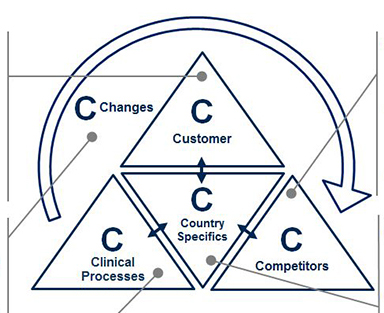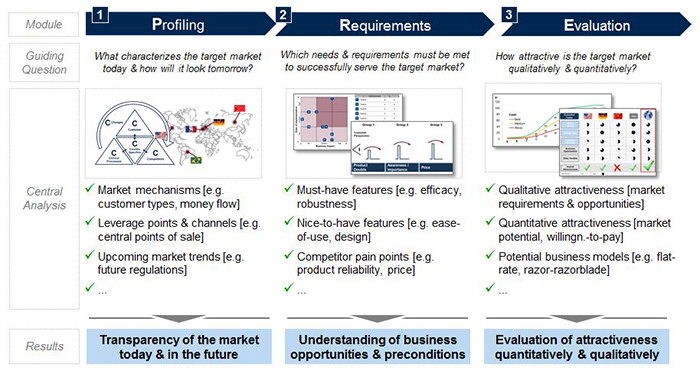How to Evaluate Attractiveness of Product Ideas and Markets Before Development

The medical device and diagnostics industry is driven by innovation, yet the 70% cross-industry failure rate indicates that most novel ideas are unsuccessful in practice. While the rewards of an innovative medtech product are lucrative, market entry typically requires high upfront investment, and consequently, a high risk in case of market failure.
Imagine the example of a medtech company that developed a groundbreaking water cutter for surgeons, a radical innovation in its field. The electrosurgical device had the capability to dissect via a water jet with varying pressure. Despite the valuable features of tissue selectivity, reduced blood loss, shorter operation times and reduced costs, surgeons did not accept the device, and the innovation flopped.
How could this happen? The most typical shortcomings of innovation failure are:
- Poor knowledge of customer needs
- Suboptimal pricing strategy
- Insufficient knowledge of the competition (including product differentiation)
- No consideration of country specifics
- Lack of investigation into the future market
To avoid such product failures in the end, it is important to focus on the beginning. By assessing the attractiveness of a market or idea before developing and launching a concrete product, the pre-analysis helps medtech companies ensure a return on investments in innovation.
The Pre-Analysis Approach to Medtech Success
The pre-analysis consists of thoroughly profiling a market’s current as well as future structure, mechanisms and central players, identifying requirements for successful market entrance, and performing an evaluation of the market revenue potential and overall attractiveness (see Figure 1). Together, all three elements create the transparency required for making an informed and sophisticated go or no-go decision on product development and market entry.

In order to complete each step, the pre-analysis process combines primary qualitative and quantitative research (e.g., market expert interviews) with secondary sources (e.g., scientific literature, market reports)—the more direct the method, the better.
Each of the steps and what they consist of will be explained in detail in the remainder of this article.
Step 1: Profiling
Precise market profiling allows for full market comprehension and transparency, in turn allowing for more accurate planning, especially as new product development progresses. To guide the profiling, the 5C framework (Customers, Competitors, Clinical Processes, Country Specifics, and Changes) provides an organized structure for evaluation (see Figure 2). Each C contains key questions to be answered in the pre-analysis for decision making on market entry and product development. Valuable sources are market expert interviews as well as analysis of secondary sources, such as market reports, scientific literature, and company and industry association websites.
- Customers may be characterized by their type and market potential. For medtech companies, customers are often grouped according to stakeholders: Hospitals, labs, physicians, health insurers, patients and others. Once identified, it is essential to categorize these stakeholder groups into sub-types. For example, what types of hospitals might be interested in the medtech product? How do these hospital types differ from one another? How many of each hospital type exist and which medtech devices do they normally use?
- Competitors and their product portfolios may be evaluated through identifying their strengths and weaknesses, as well as their individual products. Charting competitors’ products on a single matrix (e.g., with “target customer types” and “customer need fulfillment” as dimensions) helps to identify white spots or unmet needs in the market for potential entry.
- Clinical processes are crucial to proactively identify high potential customers and their medical device needs. The simplest way to analyze those is to start at the beginning of the patient flow and map their journey (e.g., first information source, diagnosis location, therapy location and monitoring location) in order to discover relevant buying centers within the previously defined customer groups. By outlining the key clinical process steps within the different customer groups, companies may easily recognize areas for improvement to boost consumption. For example, if the customer is a hospital, who uses the device, where, for what and how frequently?
- Country specifics may have a major influence on the local success of medical products. As a medtech company, recognizing the differences among potential target countries is key. The wide array of healthcare providers and insurance plans in one country alone may affect many aspects of product development, such as product features, local services and pricing. A Chinese blood donor center, for instance, tests blood samples for a different set of antigens than a Brazilian donor center. Therefore, within this “C”, the business landscape and economic framework governing the market will be classified as well as the technological benchmarks and expectations in each respective country.
- Changes in the market may manifest in positive or negative trends that affect a specific medtech area or the healthcare industry as a whole. To identify these trends, primary and secondary data research will bring objectivity. For example, through researching literature on in-vitro diagnostics technology, companies may find that immunodiagnostics will remain the standard for endocrine testing in the next years; however, molecular diagnostics is expected to quickly gain shares in the oncology field. Therefore, recent market developments and disruptive changes will be identified and their potential to impact the market evaluated, allowing for an early planning of potential counteractions.
Step 2: Requirements
After profiling the market, it is necessary to understand the requirements for new market success to complement and refine the market understanding formed in the first pre-analysis step. Companies may easily uncover these key requirements by initiating an open dialogue with market participants. Key industry experts in research or academia often have visionary ideas on the future of medtech, and they may point to the short and long-term market trends (e.g., upcoming technologies, new regulations). Key decision makers (e.g., lab directors and managers for diagnostic devices) and operative users (e.g., lab technicians and biotechnical assistants), on the other hand, can complement this information with their professional experience, overseeing key decision making. Overall, expert discussions are most valuable in determining market success factors when addressing following questions:
- Market Entrance Hurdles. What hurdles must be overcome to successfully enter the market? Entrance hurdles concentrate on common market challenges but also overall competition in the targeted market. Hurdles might be strict regulations for new products (e.g., FDA regulations) or overly strong local competitors (e.g., local market dominated by an established player).
- Willingness-to-Pay and Competitor Costs. In the diagnostics segment, willingness-to-pay for testing is often directly related to reimbursement rates. Operating costs for similar or close competitor products may additionally set the standard (e.g., costs for autoimmune testing might be assumed as standard for bone metabolism testing). Combining the insights from the expert interviews with those from secondary research may provide a clear initial willingness-to-pay estimation.
- Must-Have and Outstanding Features. Must-have features address the current industry and product needs, differentiating according to country (e.g., reliability, ease of use). Outstanding features, on the other hand, focus on the industry and product wants (e.g., full system connectivity, excellent service). This insight can be helpful in identifying an appropriate market positioning strategy for the new product/ market entry. Of course, customers’ evaluations likely differ across customer types.
- Pain Points and Unmet Needs. In addition to expert, customer interviews, end-customer interviews (e.g., patients) also help reveal pain points of current product solutions and unmet needs not addressed by any other products yet, thus, providing potential leverage for high differentiation.
Step 3: Evaluation
Following profiling and requirements, evaluation of the market potential and launch success probability completes the depiction of the new market’s attractiveness. This final step provides quantitative and qualitative results and ensures secure and informed decision making.
- Quantitative Estimation. A market potential estimation is crucial for deciding if revenue expectations are possible. To achieve this, upper and lower price limits as well as the average willingness-to-pay for the respective product/market will be used. This information will be complemented with market figures from secondary research (e.g., number of customers per customer type, used devices) and a quantitative forecast, including present and predicted future trends to estimate the market development. After the completion of the first two pre-analysis steps, this information should be readily available. For accurate validation of the assumptions, the fairly reliable predictions of market experts are essential.
- Qualitative Evaluation. The qualitative evaluation integrates all insights about the potential product and/or market for a go or no-go recommendation of product development and market entrance. Here, various scoring models may be used; for instance, a scoring model that prioritizes country specific effects (e.g., market levers), as well as opportunities and threats (e.g., local regulations, competitor strength) with achievement potential ratings according to the company’s strengths and weaknesses (e.g., fast research and development capabilities, existing technology experience) can be applied.
Pre-analysis Provides Necessary Transparency in Advance
As medtech continues to evolve and the market demands more innovation, companies must find effective ways not only to meet but even exceed expectations. Through the pre-analysis, companies will gain industry transparency via profiling, clear customer needs through requirements, and valid financial forecasts for potential innovation in evaluation.
In the initial example of the medtech company that developed the electrosurgical device, a pre-analysis would have confirmed the company’s initial understanding that there is an enormous market potential for tissue-selective surgical cutters. However, the pre-analysis would have also uncovered the fact that surgeons consider “ease of use” as a must-have feature—a critical component that was hindered by the devices long learning curve and impairing vision in surgeries.
A complete pre-analysis should take no longer than two to three months from start to finish. Compared to years of product development, this is a worthwhile time investment to fully capitalize on medtech innovation. Through the pre-analysis, medtech managers will be prepared to make sound decisions, save costs and increase return on their investment.